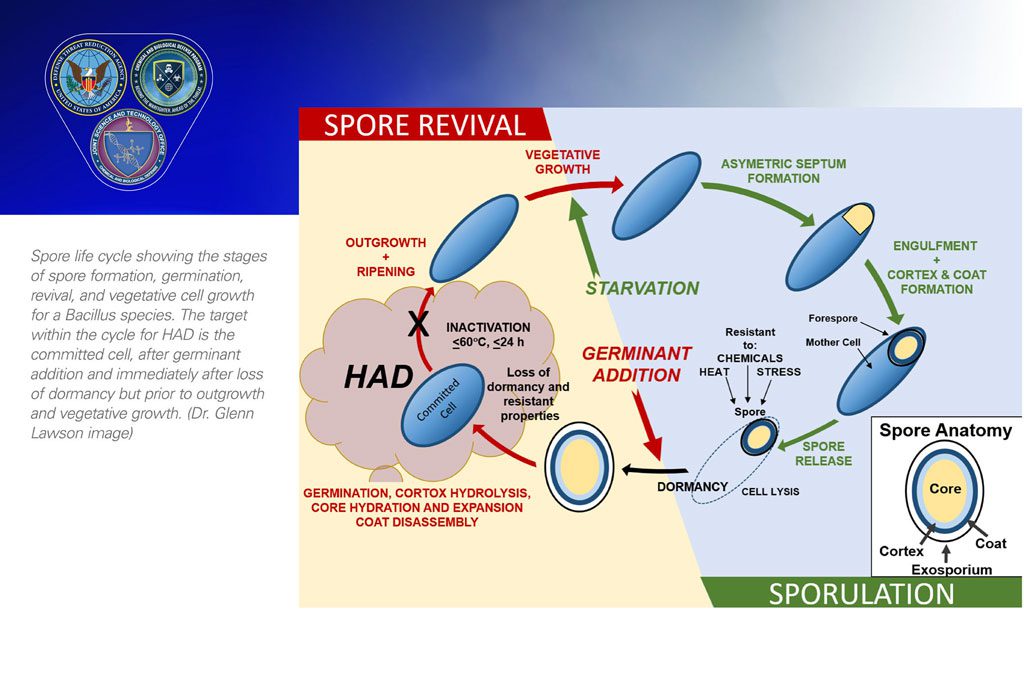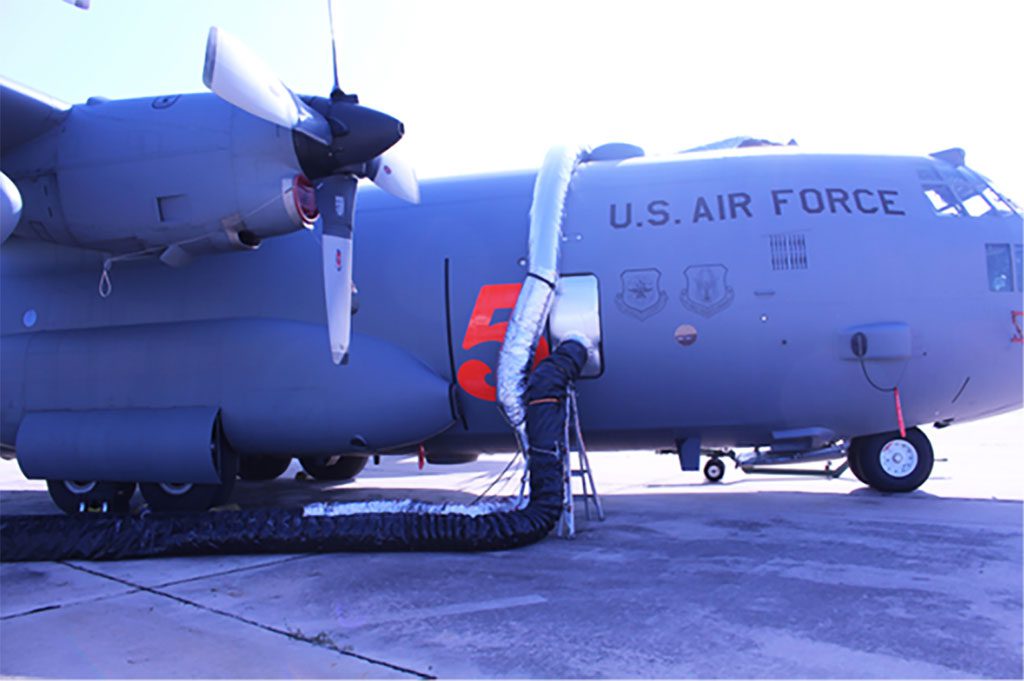New method to decrease the amount of time it takes for hot air decontamination to kill bacterial spores, such as Bacillus anthracis (anthrax), within and on aircraft.
While hot air decontamination inactivates viruses in as few as 2 hours, it presently requires more than 72 hours to kill bacterial spores. A reduction in time and temperature to kill bacterial spores will reduce costs, improve compatibility of materials, and return the aircraft to mission faster.
Researchers at the Naval Surface Warfare Center Dahlgren Division (NSWC-DD) set out to reduce the temperature and time requirements of the hot air decontamination process used by the military’s Joint Biological Agent Decontamination System (JBADS).
JBADS returns a biologically contaminated aircraft to full service without risking exposure of the biological weapons agents to aircrew members and support personnel and without corrosive or reactive decontaminants. Hot, humid air is sustained inside the enclosure for up to several days until both the interior and exterior of the aircraft are decontaminated and can be returned to operation. Although the hot air decontamination process is within materials specifications for aircraft, extended hot air exposure may affect sensitive systems, so a reduction in the required time to complete decon not only returns the aircraft to mission sooner but also improves its survivability.
Presently, the goal is to reduce the JBADS parameters for bacterial spores from greater than 167°F and 70%–90% relative humidity for at least 72 hours to lower than 140°F (60°C) for fewer than 24 hours.
[ Read more: Originally Built for Bioterrorism Agents, This Decontamination System Now Clears SARS-CoV-2 from Military Aircraft ]
The research by NSWC-DD tested a new bacterial spore germination method to make bacterial spores more susceptible to HAD at lower temperatures. Germination occurs when a bacterial spore develops into a growing, vegetative bacterial cell. While spores are resistant to environmental extremes such as heat, most vegetative bacterial cells are susceptible to higher temperatures, so causing germination and raising ambient temperature is one way kill bacterial spores.

The NSWC-DD team used a derelict C-130 aircraft and a human-safe bacterial surrogate for Bacillus anthracis to field test the bacterial spore germination process. Using a fog machine, the team evenly spread over 100 million surrogate bacterial spores per square meter on the interior surfaces of the C-130. After the spores dried, the team then applied a spore germination solution with no reactive chemicals that minimized risk to personnel and maintained aircraft materials compatibility. The team applied the germination solution with a battery-powered backpack electrostatic sprayer that was designed to evenly coat surfaces with a thin layer of the solution that included soaps to improve spreading. Because germination requires wet surfaces, the team continued to spray interior aircraft surfaces with germination solution at regular intervals of 2 hours to keep surfaces wet. After a 2-hour drying interval, the team repeated the process. The team then sampled surfaces at each interval to monitor the status of spore germination. After the final drying step, the team took samples to determine how many viable spores remained, and securely transported all samples to their laboratory for analysis.
Researchers found that the spore-germination process reduced biological spore and virus contamination by more than 99.9%. In a real situation, this would reduce risk to the Joint Forces as they pilot the contaminated aircraft to the JBADS location. In combination with JBADS, the entire process will inactivate biological contamination of aircraft to clearance levels and rapidly return the aircraft to mission. A spore-germination process will also reduce the time and temperature needed for JBADS aircraft decontamination, logistics needs, and impact to the aircraft components.
This research was sponsored by the Defense Threat Reduction Agency’s (DTRA) Chemical and Biological Technologies Department in its role as the Joint Science and Technology Office (JSTO) for the Chemical and Biological Defense Program.
READ ALSO:
Hot, Humid Air Decontamination of Aircraft Confirmed that High Temperature and High Humidity are Critical for Inactivation of Infectious, Enveloped Ribonucleic Acid (RNA) Virus. Frontiers in Bioengineering and Biotechnology, 23 October 2020
Hot, humid air decontamination of a C-130 aircraft contaminated with spores of two acrystalliferous Bacillus thuringiensis strains, surrogates for Bacillus anthracis. Journal of Applied Microbiology, 20 January 2016
Response surface modeling for hot, humid air decontamination of materials contaminated with Bacillus anthracis Sterne and Bacillus thuringiensis Al Hakam spores. Journal of Applied Microbiology, 1 May 2014
Thermal Disinfection of SARS-CoV-2 within an Airplane. Boeing, 2021
Estimated Surface Decay of SARS-CoV-2 (virus that causes COVID-19) DHS S&T, 20 Dec 2022


